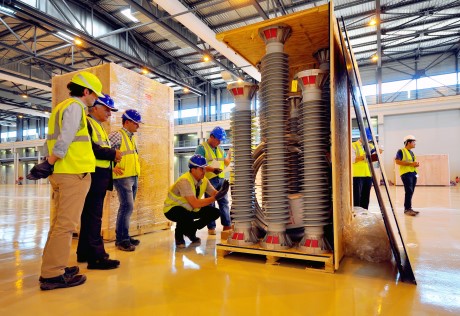The first plant system components were delivered yesterday to the ITER construction site in Saint Paul-lez-Durance, France.
 |
| Workers check the contents of the four crates delivered to the ITER site (Image: ITER) |
This first delivery provided a "concrete opportunity" to test the administrative, technical, industrial and regulatory procedures that will accompany the procurement of plant and machine components by the ITER members, ITER said.
Shipped from the USA in four crates, the 12 high-voltage surge arrestors that arrived at the site by truck are part of the US contribution to the installation's steady state electrical system, ITER said.
The surge arresters belong to a large system that will be installed between the 400 kV switchyard and the transformers that feed power to the ITER plant systems and components. As their name suggests, they are designed to protect the transformers from a major voltage surge that can be caused by lightning, ITER said.
"These are the first of many thousands of components to be delivered to ITER by the project's members," said Ken Blackler, head of ITER's assembly and operations division, as the crates were being unloaded. "In this historic and meaningful moment, I wish to thank the US Domestic Agency for procuring the components, the logistics service provider DAHER for handling the shipment all the way from New York, and the European Domestic Agency for providing temporary storage on the ITER site," he said.
Sergio Orlandi, ITER's head of plant system engineering, said "the timely delivery of these first plant components - in conformity with the schedule proposed in 2010 - is an example to be followed."
The remaining components needed to connect the ITER installation to the dedicated 400 kV switchyard are expected before the end of the month on site. Their installation should begin early 2015, ITER said.
ITER is a global collaboration to build the largest experimental fusion facility. Europe will contribute almost half of the costs of its construction, while the other six members - China, India, Japan, Korea, Russia and the USA - will contribute equally to the rest.
Superconducting lengths for PF1 coil
D. V. Efremov Scientific Research Institute of Electrophysical Apparatus has completed the joint manufacture with Russia’s European ITER partners of the first two unit lengths of the superconductor for ITER's magnet system, for the PF1 coil, Russia’s Rosatom said today.
The ITER magnet system comprises 18 superconducting toroidal field and six poloidal field coils, a central solenoid, and a set of correction coils that magnetically confine, shape and control the plasma inside the vacuum vessel. The poloidal field (PF) magnets pinch the plasma away from the walls and contribute in this way to maintaining the plasma's shape and stability. The PF is induced both by the magnets and by the current drive in the plasma itself.
Russia is responsible for manufacturing two copper dummies, one superconducting dummy, nine superconducting unit lengths for the PF6 coil, and 17 unit superconducting lengths for the PF1 coil.
Early in 2013, the Italian company Criotec completed the manufacture of the first copper dummy conductor for the PF1 poloidal field coil using cable that had been manufactured in Russia. The cable is composed of superconducting niobium-titanium strands produced by the Chepetsky Mechanical Plant in Udmurtia, Russia.
Researched and written
by World Nuclear News




_69218.jpg)

_50545.jpg)
_28367.jpg)
_76087_55556.jpg)




